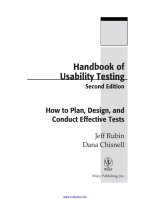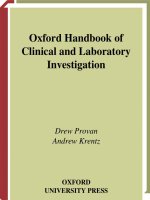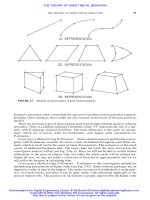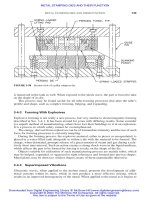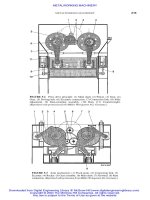- Trang chủ >>
- Y - Dược >>
- Ngoại khoa
oxford american handbook of clinical medicne 2nd ed
Bạn đang xem bản rút gọn của tài liệu. Xem và tải ngay bản đầy đủ của tài liệu tại đây (16.97 MB, 873 trang )
OXFORD
AMERICAN
HANDBOOK OF
CLINICAL
MEDICINE
Second Edition
Published and forthcoming Oxford American Handbooks
Oxford American Handbook of Clinical Medicine
Oxford American Handbook of Anesthesiology
Oxford American Handbook of Cardiology
Oxford American Handbook of Clinical Dentistry
Oxford American Handbook of Clinical Diagnosis
Oxford American Handbook of Clinical Pharmacy
Oxford American Handbook of Critical Care
Oxford American Handbook of Disaster Medicine
Oxford American Handbook of Emergency Medicine
Oxford American Handbook of Endocrinology and Diabetes
Oxford American Handbook of Geriatric Medicine
Oxford American Handbook of Hospice and Palliative Medicine
Oxford American Handbook of Infectious Diseases
Oxford American Handbook of Nephrology and Hypertension
Oxford American Handbook of Neurology
Oxford American Handbook of Obstetrics and Gynecology
Oxford American Handbook of Oncology
Oxford American Handbook of Otolaryngology
Oxford American Handbook of Pediatrics
Oxford American Handbook of Physical Medicine and Rehabilitation
Oxford American Handbook of Psychiatry
Oxford American Handbook of Pulmonary Medicine
Oxford American Handbook of Radiology
Oxford American Handbook of Reproductive Medicine
Oxford American Handbook of Rheumatology
Oxford American Handbook of Sports Medicine
Oxford American Handbook of Surgery
Oxford American Handbook of Urology
OXFORD
AMERICAN
HANDBOOK OF
CLINICAL
MEDICINE
Second Edition
EDITED BY
JOHN A. FLYNN, MD, MBA, MED
GENERAL INTERNAL MEDICINE
AND RHEUMATOLOGY
JOHNS HOPKINS UNIVERSITY
MICHAEL J. CHOI, MD
MEDICINE AND NEPHROLOGY
JOHNS HOPKINS UNIVERSITY
L. DWIGHT WOOSTER, MD
MEDICINE AND PULMONARY DISEASE
JOHNS HOPKINS UNIVERSITY
3
1
Oxford University Press is a department of the University of Oxford.
It furthers the University’s objective of excellence in research, scholarship,
and education by publishing worldwide.
Oxford New York
Auckland Cape Town Dar es Salaam Hong Kong Karachi
Kuala Lumpur Madrid Melbourne Mexico City Nairobi
New Delhi Shanghai Taipei Toronto
With offices in
Argentina Austria Brazil Chile Czech Republic France Greece
Guatemala Hungary Italy Japan Poland Portugal Singapore
South Korea Switzerland Thailand Turkey Ukraine Vietnam
Oxford is a registered trademark of Oxford University Press
in the UK and certain other countries.
Published in the United States of America by
Oxford University Press
198 Madison Avenue, New York, NY 10016
© Oxford University Press, 2013
All rights reserved. No part of this publication may be reproduced, stored in a
retrieval system, or transmitted, in any form or by any means, without the prior
permission in writing of Oxford University Press, or as expressly permitted
by law, by license, or under terms agreed with the appropriate reproduction
rights organization. Inquiries concerning reproduction outside the scope of the
above should be sent to the Rights Department, Oxford University Press, at the
address above.
You must not circulate this work in any other form
and you must impose this same condition on any acquirer.
Library of Congress Cataloging-in-Publication Data
Oxford American handbook of clinical medicine / edited by John A. Flynn, Michael
J. Choi, L. Dwight Wooster.— 2nd ed.
p. ; cm.—(Oxford American handbooks)
Adapted from: Oxford handbook of clinical medicine / Murray Londmore, et al. 8th
ed. 2010.
Includes bibliographical references and index.
ISBN 978–0–19–991494–4 (alk. paper)—ISBN 978–0–19–998515–9 (alk. paper)—
ISBN 978–0–19–998516–6 (alk. paper)
I. Flynn, John A., MD. II. Choi, Michael J. III. Wooster, L. Dwight (Lyman
Dwight)
IV. Oxford handbook of clinical medicine. V. Series: Oxford American handbooks.
[DNLM: 1. Clinical Medicine—Handbooks. WB 39]
LC Classification not assigned
616—dc23 2012038115
9 8 7 6 5 4 3 2 1
Printed in the United States of America
on acid-free paper
v
Preface
The Hippocratic Oath is a pledge by all physicians to practice medicine
ethically and honestly. As part of that oath, our beliefs hold a promise
“to teach (our students) this art, if they desire to learn it, without fee or
covenant; to give a share of precepts and oral instruction and all the other
learning to … pupils who have signed the covenant and have taken an oath
according to the medical law…”. Clearly, as we were embarking on writing
and editing this medical text, we were not dwelling on the magnitude of
this late 5th-century Greek work. We were, nonetheless, thinking about
and motivated by the long-standing tradition in medicine of sharing medi-
cal knowledge with colleagues, especially with our students of medicine. In
contrast to the early days of medicine, this sharing of medical knowledge is
distributed to all cultures and all countries and is incredibly more open to
all who “desire to learn it.”
The Oxford American Handbook of Clinical Medicine is particularly writ-
ten for physicians-in-training; students in medical school and physicians in
their residency. The tradition of teaching and sharing medical information
had its beginnings at our hospital more than 120 years ago. It is here that
Sir William Osler wrote and published, in 1892, The Principles and Practice
of Medicine . This book was heralded as the most current work of clinical
management of patients based on known scientific principles. In addition
to his review of the science of medicine, Osler’s text provided sage advice
on the art of compassionate patient care. Unlike in the days of Osler, we
now have access to current medical information at the speed of electrons
with our various hand-held devices, search engines, and electronic medical
records. As a result, now more than ever, our trainees must assiduously
balance the science of medicine with the art of medicine. Although this
handbook is replete with medical information, as authors and editors we
also worked diligently to balance the art and compassionate delivery of
medicine with the facts of clinical decisions. We are acutely aware of new
health care policies, both local and national, of clinical cost containment,
of the importance of quality medical outcomes with high efficiency, and
with goals of professionalism. In this new edition, we have attempted to
incorporate these aspects into medical decision-making processes and rec-
ommendations for accurate diagnosis and treatment.
This book aims to present both the science and the art of patient man-
agement. Our trainees are challenged in their clinical years to remember
and assimilate an enormous volume of medical information; additionally,
students of medicine are applying and synthesizing this material within the
context of their care of patients in the hospital and the outpatient envi-
ronment. The process of integrating medical knowledge with patient care
is a repetitive one, in which learning will come in many forms and from
numerous sources. This book is one of those sources. The Oxford American
Handbook of Clinical Medicine is designed as a reference when contemplat-
ing symptoms and signs and medical conditions. Although relatively small
and constructed to fit into pockets or backpacks, this text is formatted to
accommodate the growth and development of your medical knowledge.
The contributors of this manual have the understanding and experience
to emphasize one of the grandest sources of medical knowledge—your
patients. As you interact with each patient, questions will arise; use each
clinical question and each patient experience to stimulate your quest for
medical knowledge. Allow your patients to become the foundations of this
knowledge; allow your patient’s illnesses and their reactions to their ill-
nesses and treatments to formulate your compassion and your art of medi-
cine. Relish the journey; it will last a lifetime.
This page intentionally left blank
vii
Acknowledgments
We, the three editors of the Oxford American Handbook of Clinical Medicine ,
express our most profound gratitude to all of the authors who have con-
tributed to this book. These contributors are highly respected colleagues
from the Johns Hopkins School of Medicine. They have been fastidious in
their development of these chapters, incorporating the most recent evi-
dence-based guidelines into clinical practice.
We also have the distinct privilege of participating in the care of our patients
while teaching physicians-in-training within Johns Hopkins Medicine. The
care of patients, the recognition of their ills, the definition of their clinical
problems, and the provision of their care are the foundations of the prac-
tice of medicine. This privilege of caring, cemented by medical knowledge, is
commonly a bilateral interaction shared mutually whether with our patients
or with our students. Through these interactions we have learned as much
as we have imparted.
The sharing of medical information with our colleagues, our students, and
our patients is imperative for successful health care. The presentation of
current, accurate, and dependable medical knowledge is essential for suc-
cessful, evidence-based quality outcomes for our patients. Our participation
in writing and editing this medical text was motivated by our indebtedness
to our patients and our students.
We also wish to acknowledge all of the efforts provided by Oxford University
Press, in particular Andrea Seils, Senior Editor of Clinical Medicine. She has
served throughout this effort as a steadfast advocate for the excellence and
clarity of this text. Her many hours of dedication and profound patience
are greatly appreciated.
JF would like to thank his children, Emilee, John, Sarah, Jayne, Christian,
Patrick, and W. Andrew for their constant support of one another as our
family advances. He also wishes to thank Bill Baumgartner for his mentor-
ship. Most importantly he must thank Monica—his wife, his life—for her
infinite support and strength during the past 35 years of being together.
MC would like to thank his wife Mia, his son Chris, and his daughter Julia for
their endless support and infinite patience. They have forgiven him far too
many things. He would like to thank his parents for always doing their best
for him. He would also like to thank his mentor Pedro Fernandez, on behalf
of all of his mentees, for simply making us better doctors.
DW extends his appreciation to his fianc é e, Tina Blasi, who has unequivo-
cally supported his decision to work on this text; she has been his cor-
nerstone and source of encouragement. Tina’s love and devotion are his
emotional foundations from which he changed professional paths and
expanded his professional and personal horizons. Additionally, his children
Ashley, Margaux, and Tyler are universally helpful in contributing to his
energy and ideas, and to his wish for better health care for them and for
their children. He also wishes to thank Mike Weisfeldt for giving him the
opportunity to join the faculty of Johns Hopkins’ Medicine.
Finally, we wish to dedicate this book to Dr. Frederick L. Brancati for being
a constant source of strength, courage, and guidance to us, through not
only his words but through his actions.
This page intentionally left blank
Contents
Preface v
Acknowledgments vii
List of contributors xi
Symbols and abbreviations xiii
1 Thinking about medicine
1
2 Epidemiology
26
3 Clinical skills
36
4 Symptoms and signs
70
5 Cardiovascular medicine
88
6 Pulmonary medicine
150
7 Gastroenterology
202
8 Renal medicine
250
9 Endocrinology
284
10 Neurology
328
11 Rheumatology and musculoskeletal conditions
398
12 Oncology
420
13 Surgery
438
14 Infectious diseases (ID)
518
15 Hematology
608
16 Geriatric medicine
642
17 Biochemistry
654
18 Radiology
684
19 Practical procedures
718
20 Emergency Medicine
734
Index 800
This page intentionally left blank
xi
List of Contributors
Sumera Ali, M.D.
Johns Hopkins University
Radiology
Arjun S. Chanmugam,
M.D.
Johns Hopkins University
Emergency Medicine
Colleen Christmas,
M.D.
Johns Hopkins University
Geriatric Medicine
April Fitzgerald,
M.D.
Johns Hopkins University
Signs and Symptoms
John A. Flynn,
M.D., M.B.A., M.ED.
Johns Hopkins University
Rheumatology
Matthew Foy,
M.D.
Louisiana State University
Renal Medicine
Susan L. Gearhart,
M.D.
Johns Hopkins University
Surgery
Mark T. Hughes,
M.D., M.A.
Johns Hopkins University
Thinking About Medicine
Joshua D. King,
M.D.
University of Virginia
Biochemistry
Daniel Laheru,
M.D.
Johns Hopkins University
Oncology
L. David Martin,
M.D.
Johns Hopkins University
Signs and Symptoms
Alison R. Moliterno,
M.D.
Johns Hopkins University
Hematology
Kendall F. Moseley,
M.D.
Johns Hopkins University,
Endocrinology
Rodney Omron,
M.D., M.P.H.
Johns Hopkins University
Emergency Medicine
Gregory P. Prokopowicz,
M.D.,
M.P.H.
Johns Hopkins University
Epidemiology
Jason Rosenberg,
M.D.
Johns Hopkins University
Neurology
Stuart Russell,
M.D.
Johns Hopkins University
Cardiovascular Medicine
Paul E. Segal,
D.O.
Johns Hopkins University
Biochemistry
Shmuel Shoham,
M.D.
Johns Hopkins University
Infectious Disease
Lanaya W. Smith,
M.D.
Johns Hopkins University
Rheumatology
Ellen M. Stein,
M.D.
Johns Hopkins University
Gastroenterology
C. Matthew Stewart,
M.D., PH.D.
Johns Hopkins University
Practical Procedures
Rosalyn W. Stewart,
M.D., M.S.
Johns Hopkins University
Practical Procedures
Sumeska Thavarajah,
M.D.
Johns Hopkins University
Renal Medicine
Clifford R. Weiss,
M.D.
Johns Hopkins UniversityRadiology
L. Dwight Wooster
M.D.
Johns Hopkins University
Pulmonary Medicine
This page intentionally left blank
xiii
Symbols and abbreviations
1° Primary
2° Secondary
–ve; +ve negative and positive, respectively
6-MP thiopurine
A
2
aortic component of second heart sound
A
2
A angiotensin-2 receptor antagonist (AT-2, A2R, and AIIR)
Ab antibody
ABC airway, breathing, and circulation: basic life support
ABG arterial blood gas measurement ( P aO
2
, P aCO
2
, pH, HCO
3
–
)
ABI ankle brachial index
ABPA allergic bronchopulmonary aspergillosis
ac ante cibum (before food)
ACE angiotensin-converting enzyme
ACS acute coronary syndrome
ACTH adrenocorticotropic hormone
AD Alzheimer’s disease
ADH antidiuretic hormone
Ad lib ad libitum; as much/as often as wanted (Latin for at pleasure )
ADL activities of daily living
AF atrial fibrillation
AFB acid-fast bacillus
AFP (and α -FP) α -fetoprotein
Ag antigen
AIDS acquired immunodeficiency syndrome
AIH autoimmune hepatitis
AIN acute interstitial nephritis
AKI acute kidney injury
alk phos alkaline phosphatase (also ALP)
ALL acute lymphoblastic leukemia
AMA antimitochondrial antibody
AML acute myeloid leukemia
AMP adenosine monophosphate
ANA antinuclear antibody
ANCA antineutrophil cytoplasmic antibody
APTT activated partial thromboplastin time
AR aortic regurgitation
ARB angiotensin receptor blocker
ARDS acute respiratory distress syndrome
ARF acute renal failure
ART antiretroviral therapy
AS aortic stenosis
ASD atrial septal defect
ASO(T) antistreptolysin o (titer)
AST aspartate transaminase
xiv
AT-2 angiotensin-2 receptor blocker (also AT-2, A2R, and AIIR)
ATN acute tubular necrosis
ATP adenosine triphosphate
AV atrioventricular
AVM arteriovenous malformation(s)
AVNRT AV nodal reentry tachycardia
AVRT AV reentry tachycardia
AXR abdominal x-ray (plain)
AZA azathioprine
AZT zidovudine
Ba barium
BAL bronchoalveolar lavage
BET benign essential tremor
BHL bilateral symmetrical hilar lymphadenopathy
BID bis die (twice a day)
BKA below-knee amputation
BMD bone mineral density
BMI body mass index
BNP brain natriuretic peptide
BP blood pressure
bpm beats per minute (e.g., pulse)
BUN blood urea nitrogen
ca carcinoma
Ca calcium
CABG coronary artery bypass graft
CAD coronary artery disease
cAMP cyclic adenosine monophosphate (AMP)
CAP community-acquired pneumonia
CAPD continuous ambulatory peritoneal dialysis
CBC complete blood count
CBD common bile duct
CC creatinine clearance
CCPD continuous cyclic peritoneal dialysis
CCU coronary care unit
CDC Centers for Disease Control, U.S.
CEA carcino-embryonic antigen
CF cystic fibrosis
CGM continuous glucose monitoring
CHB complete heart block
CHD coronary heart disease (related to ischaemia and atheroma)
CHF congestive heart failure (i.e., left and right heart failure)
Chol cholesterol
CI contraindications
CIPD chronic inflammatory demyelinating polyradiculoneuropathy
CK creatine (phospho)kinase (also CPK)
xv
CKD chronic kidney disease
CLL chronic lymphocytic leukemia
CML chronic myeloid leukemia
CMV cytomegalovirus
CNS central nervous system
CONS coagulase-negative Staphylococcus
COPD chronic obstructive pulmonary disease
COX cyclo-oxygenase
CPAP continuous positive airways pressure
CPPD calcium pyrophosphate dihydrate
CPR cardiopulmonary resuscitation
CRC colorectal cancer
CrCl creatinine clearance
CRF chronic renal failure
CRP C-reactive protein
CRRT continuous renal replacement therapy
CSF cerebrospinal fluid
CT computed tomography
CVD cardiovascular disease
CVP central venous pressure
CVS cardiovascular system
CXR chest x–ray
d day(s) (also expressed as ´/7)
DC direct current
DIC disseminated intravascular coagulation
DIP distal interphalangeal
dL deciliter
DEXA dual energy x-ray absorptiometry
DLCO diffusing capacity of lung
DM diabetes mellitus
DOT directly observed therapy
DTPA diethylenetriamine penta-acetic acid
DU duodenal ulcer
D&V diarrhea and vomiting
DVT deep venous thrombosis
EAA extrinsic allergic alveolitis
EBM evidence-based medicine
EBV Epstein–Barr virus
ECG electrocardiogram
Echo echocardiogram
EDTA ethylene diamine tetraacetic acid (e.g., in a CBC bottle)
EEG electroencephalogram
EKG electrocardiogram; also ECG
EGD esophagogastric-duodenoscopy
ELISA enzyme linked immunosorbent assay
xvi
EM electron microscope
EMG electromyogram
ENT ear, nose, and throat
ERCP endoscopic retrograde cholangiopancreatography
ESR erythrocyte sedimentation rate
ESRD end-stage renal disease
EUA examination under anesthesia
EUS endoscopic ultrasonography
EVAR endovascular aneurysm repair
FB foreign body
FDA U.S. Food and Drug Administration
FDP fibrin degradation products
FEV
1
forced expiratory volume in first second
FFP fresh frozen plasma
FGF fibroblast growth factor
FH family history
FHF fulminant hepatic failure
F
i
O
2
partial pressure of O2 in inspired air
FNA fine needle aspiration
FROM full range of movements
FSH follicle-stimulating hormone
FUO fever of unknown origin
FVC forced vital capacity
g gram
GA general anesthetic
GB gall bladder
GC gonococcus
GCA giant cell arteritis
GCS Glasgow Coma Scale
GERD gastroesophageal reflux disease
GFR glomerular filtration rate
GGT gamma glutamyl transpeptidase
GH growth hormone
GI gastrointestinal
G6PD glucose-6-phosphate dehydrogenase
GN glomerulonephritis
GPA granulomatosis with polyangiitis
GTT glucose tolerance test (also OGTT: oral GTT)
GU genitourinary; also gastric ulcer
h hour
HAART highly active antiretroviral therapy
HAP hospital-acquired pneumonia
HAV hepatitis A virus
Hb hemoglobin
HBsAg/HBV hepatitis B surface antigen/hepatitis B virus
xvii
HBIG hepatitis B immune globulin
HCAP health care acquired pneumonia
HCC hepatocellular cancer
Hct hematocrit
HCV hepatitis C virus
HD hemodialysis
HDL high-density lipoprotein
HDV hepatitis D virus
HELLP hemolysis, elevated liver enzymes, low platelet count
syndrome
HH hereditary hemochromatosis
HHS hyperosmolar hyperglycemic state
HHT hereditary hemorrhagic telangiectasia
HHV human herpes virus
HIDA hepatic iminodiacetic acid
HIT heparin-induced thrombocytopenia
HIV human immunodeficiency virus
HLA human leukocyte antigen
HOCM hypertrophic obstructive cardiomyopathy
HONK hyperosmolar nonketotic (diabetic coma)
HPV human papilloma virus
HRCT high-resolution computed tomography
HRS hepatorenal syndrome
HRT hormone replacement therapy
HSV Herpes simplex virus
HTN hypertension
HUS hemolytic uremic syndrome
IBD inflammatory bowel disease
IBS irritable bowel syndrome
ICP intracranial pressure
ICS intercostal space
ICU intensive care unit
IDA iron-deficiency anemia
IDDM insulin-dependent diabetes mellitus
IFN- α α interferon
IE infective endocarditis
IFG impaired fasting glucose
Ig immunoglobulin
IGRA interferon gamma release assay
IGT impaired glucose tolerance
IHD ischemic heart disease
IL interleukin
IM intramuscular
IMNM immune-mediated necrotizing myopathy
IND indinavir
xviii
INR international normalized ratio (prothrombin ratio)
IPPV intermittent positive pressure ventilation
ISH isolate systolic hypertension
ITP idiopathic thrombocytopenic purpura
iu international unit
IVC inferior vena cava
IVDU intravenous drug user
IVIG intravenous immunoglobulin
IVF
IV(I) intravenous (infusion)
IVU intravenous urography
JVP jugular venous pressure
K potassium
kg kilogram
L liter
LA left atrium of heart
LAD left axis deviation on the ecg
LBBB left bundle branch block
LDH lactate dehydrogenase
LDL low-density lipoprotein
LFT liver function test
LH luteinizing hormone
LLQ left lower quadrant
LMN lower motor neuron
LMWH low-molecular-weight heparin
LMP last menstrual period
LP lumbar puncture
LR lactated Ringer’s
LRD living related donor
LTOT long term oxygen therapy
LUQ left upper quadrant
LV left ventricle of the heart
LVF left ventricular failure
LVH left ventricular hypertrophy
LVOT left ventricular outflow tract
μg microgram
MAI Mycobacterium avium intracellulare
MAOI monoamine oxidase inhibitors
MC & S microscopy, culture, and sensitivity
MCP metacarpophalangeal joints
MCV mean cell volume
MDCT multidetector computed tomography
MDMA 3,4-methylenedioxymethamphetamine
MDRD Modification of Diet in Renal Disease
MELD model for end-stage liver disease
xix
MET maximal exercise test
mg milligram
Mg magnesium
MI myocardial infarction
min(s) minute(s)
mL milliliter
mm Hg millimeters of mercury
MEN multiple endocrine neoplasia
MMSE Mini-Mental Status Examination
MND motor neuron disease
MPA microscopic polyangiitis
MR mitral regurgitation
MRA magnetic resonance angiography
MCRP magnetic resonance cholangiopancreatography
MRI magnetic resonance imaging
MRSA methicillin-resistant Staphylococcus aureus
MS multiple sclerosis (do not confuse with mitral stenosis)
MSM men who have sex with men
MSSA methicillin sensitive Staphylococcus aureus
MSU midstream urine
Na sodium
NAAT nucleic acid amplification test
NAD nothing abnormal detected
ND notifiable disease
ng nanogram
NG(T) nasogastric (tube)
NHANES National Health and Nutrition Examination Survey
NICE National Institute for Health and Clinical Excellence
NIDDM noninsulin-dependent diabetes mellitus
NIPD night intermittent peritoneal dialysis
NMDA n -methyl- d -aspartate
NNRTI non-nucleoside reverse transcriptase inhibitor
NNT number needed to treat, for 1 extra satisfactory result
NPO nothing by mouth
NR normal range—the same as reference interval
NRTI nucleoside reverse transcriptase inhibitor
NS normal saline
NSAIDs nonsteroidal anti-inflammatory drugs
NTG nitroglycerin (also TNG)
N&V nausea and/or vomiting
NYHA New York Heart Association
OA osteoarthritis
OD overdose
OGTT oral glucose tolerance test
OP opening pressure
xx
OPD outpatient department
ORh– blood group O, Rh negative
OT occupational therapist
P
2
pulmonary component of second heart sound
P
a
CO
2
partial pressure of carbon dioxide in arterial blood
PAD peripheral artery disease
PAN polyarteritis nodosa
P
a
O
2
partial pressure of oxygen in arterial blood
PAS periodic acid-Schiff
PBC primary biliary cirrhosis
PCN penicillin
PCOS polycystic ovary disease
PCR polymerase chain reaction (DNA diagnosis)
PCV packed cell volume
PD peritoneal dialysis; also Parkinson’s disease
PDGF platelet-derive growth factor
PE pulmonary embolism
PEEP positive end-expiratory pressure
PERLA pupils equal and reactive to light and accommodation
PEF(R) peak expiratory flow (rate)
PET positron emission tomography
PFT pulmonary function tests
PI protease inhibitor
PID pelvic inflammatory disease
PIP proximal interphalangeal (joint)
PMH past medical history
PMR polymyalgia rheumatica
PND paroxysmal nocturnal dyspnea
PO per os (by mouth)
POEM peroral endoscopic myotomy
PPF purified plasma fraction (albumin)
PPI proton pump inhibitor; e.g., omeprazole, lansoprazole, etc.
PR per rectum (by the rectum)
PRN pro re nata (as required)
PSA prostate specific antigen
PSC primary sclerosing cholangitis
PTCA percutaneous transluminal coronary angioplasty
PTH parathyroid hormone
PTT prothrombin time
PTU propylthiouracil
PUD peptic ulcer disease
qd each day
qid quater in die (4 times a day); qqh: quarta quaque hora
(every 4h)
R right
RA rheumatoid arthritis; also right atrium of heart
xxi
RAD right axis deviation on the ECG
RBBB right bundle branch block
RBC red blood cell
RCT randomized controlled trial
RF renal failure
R/O rule out
RLQ right lower quadrant
RUQ right upper quadrant
RV right ventricle of heart; also residual volume of lung
RVF right ventricular failure
RVH right ventricular hypertrophy
 recipe (treat with)
s or sec second(s)
S1, S2 first and second heart sounds
SARS severe acute respiratory syndrome
SBE subacute bacterial endocarditis (IE, infective endocarditis ,
is better)
SBP spontaneous bacterial peritonitis
SC subcutaneous
SCD spontaneous compression device
SD standard deviation
SE side effect(s)
SEER Surveillance Epidemiology and End Results program
SEM systolic ejection murmur
SL sublingual
SLE systemic lupus erythematosus
SOB short of breath
SPECT single positron emission computed tomography
SQ subcutaneous
SR slow-release (also called modified-release)
SNRI serotonin-norepinephrine reuptake inhibitor
SSRI selective serotonin reuptake inhibitor
stat statim (immediately; as initial dose)
STD/STI sexually transmitted disease; sexually transmitted infection
SVC superior vena cava
SVT supraventricular tachycardia
sy(n) syndrome
T ° temperature
t
½
biological half-life
T1DM type 1 diabetes mellitus
T2DM type 2 diabetes mellitus
T3 triiodothyronine
T4 thyroxine
TB tuberculosis
TCC transitional cell carcinoma
TFTs thyroid function tests (e.g., tsh)
xxii
TIA transient ischemic attack
TIBC total iron binding capacity
Tid ter in die (3 times a day)
TEE trans-esophageal echocardiogram
TENS transcutaneous electrical nerve stimulation
TGF tumor growth factor
TLC total lung capacity
TLS tumor lysis syndrome
TMP/SMX trimethoprim/sulfamethoxazole
TNF tumor necrosis factor
TPR temperature, pulse, and respirations count
TR tricuspid regurgitation
TRH thyroid-releasing hormone
Trig triglycerides
TSH thyroid-stimulating hormone
TSST toxic shock syndrome toxin
TTE trans-thoracic echocardiogram
TTP thrombotic thrombocytopenic purpura
TUIP transurethral incision of the prostate
TURP transurethral resection of the prostate
U units
UC ulcerative colitis
U&E urea & electrolytes & creatinine in plasma, unless stated
otherwise
UDCA ursodeoxycholic acid
UMN upper motor neuron
URT upper respiratory tract
URTI upper respiratory tract infection
US(S) ultrasound (scan)
UTI urinary tract infection
VAP ventilator-acquired pneumonia
VAT video-assisted thorascopy
VDRL Venereal Diseases Research Laboratory
VEGF vascular endothelial growth factor
VISA/VRSA vancomycin intermediate/resistant Staphylococcus aureus
VF ventricular fibrillation
VLDL very low density lipoprotein
VMA vanillyl mandelic acid (HMMA)
V./Q. ventilation/perfusion ratio
VSD ventriculo-septal defect
VT ventricular tachycardia
WBC white blood cell
WCC white cell count
wk(s) week(s)
WPW Wolff-Parkinson-White syndrome
WHO World Health Organization
xxiii
Other abbreviations are given on pages where they occur: consult the
index .
WR Wassermann reaction
yr(s) year(s)
ZN Ziehl–Neelsen (stain for acid-fast bacilli; e.g., mycobacteria)
1 Thinking about medicine
Thinking about medicine
Mark T. Hughes , M.D., M.A.
Contents
Ideals 1
Ideal and less than ideal methods of care 1
Health and medical ethics 1
The bedside manner and communication skills 3
Asking questions 4
What is the mechanism? Finding narrative answers 6
Medicine, art, and the humanities 7
The art and science of diagnosing 9
Prevention 10
Prescribing drugs 12
Is this new treatment any good? (Analysis and meta-analysis) 13
Resource allocation and distributive justice 14
Quality and safety 15
Psychiatry on medical and surgical wards 17
Difficult patients 18
Death: Diagnosis and management 18
Facing death 20
Palliative care 22
Surviving residency 23
On being busy: Corrigan’s secret door
24
Ideals
Decision and intervention are the essence of action. Reflection and conjec-
ture are the essence of thought. The essence of medicine is combining these
realms of decision and intervention in the service of others. We offer these
ideals to stimulate both thought and action: Like the stars, these ideals are
hard to reach—but they serve for navigation during the night.
Ê Remember the goal of healing is to make the person whole: This applies
whether the aim is cure, relief of symptoms in an acute or chronic illness,
prevention of complications in a chronic disease, or comfort in an incur-
able disease.
Ê Do not blame the sick for being sick: They come to you for help. You are
there for them, not the other way around.
Ê If the patient’s wishes are known, comply with them .
Ê Work for your patients, not your attending .
Ê Use ward rounds to boost the patient’s morale , not your own.
Ê Treat the whole patient , not the disease.
Ê Admit people —not “strokes,” “infarcts,” “shooters,” or “gomers.”
Ê Spend time with the bereaved ; you can help them shed their tears.
Ê Question your conscience —however strongly it tells you to act.
Ê Respect the opinions of nurses; they know the patient, spend the most time
with the patient, and are usually right.
Ê Work as a team member; everyone on the interdisciplinary team has a
valuable role in the patient’s care.
Ê Be kind to yourself —you are not an inexhaustible resource.
Ê Give the patient (and yourself) time : Time to ask questions, time to reflect,
time to allow healing to take place, and time to gain autonomy.
Ê Give the patient the benefit of the doubt . If you can, be optimistic : Patients
want physicians to be realistic but also to instill hope.

